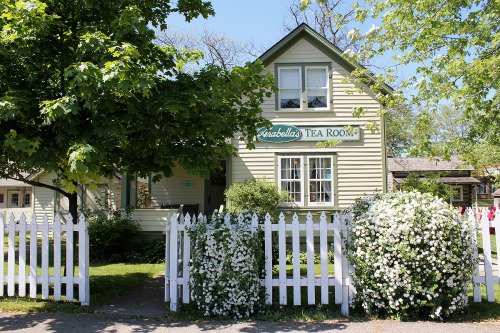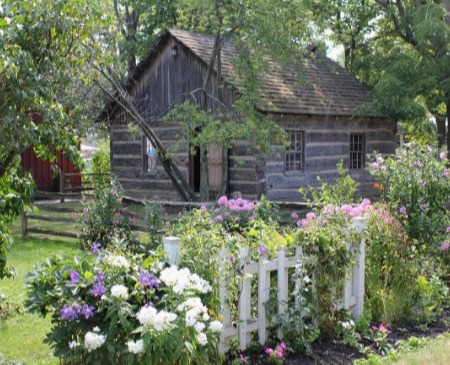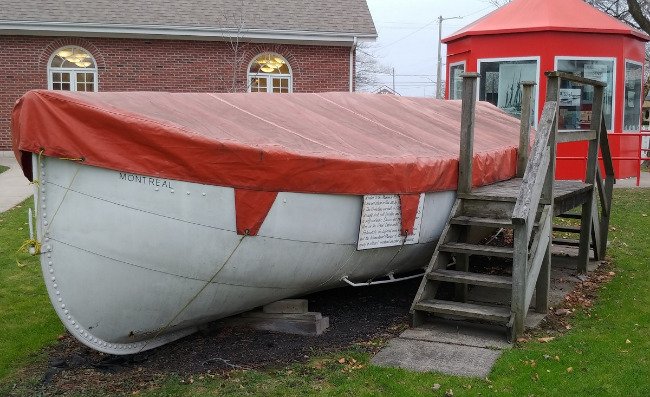 Visit our grounds where heritage buildings are set among majestic trees and historic gardens. Take a leisurely stroll along the pathways, admire the antique ironwork fencing, enjoy the shade in the memorial pavilion during your picnic lunch.
Visit our grounds where heritage buildings are set among majestic trees and historic gardens. Take a leisurely stroll along the pathways, admire the antique ironwork fencing, enjoy the shade in the memorial pavilion during your picnic lunch.
Williams House Museum (1861) |
| John and Maria Judith Williams built this Georgian Revival style home in 1861. Arabella Williams, daughter of John and Maria Williams, gifted her home and property to the City of Port Colborne in 1950. Inside are the main museum galleries, reception and gift shop, and accessible washrooms. |
Carriage House (1870)  |
| The Carriage House is one of the buildings original to the Williams estate. Hand-hewn beams support the two-story structure with board and batten siding. Inside, you will find Arabella Williams' carriage, and exhibits. |
Memorial Pavilion (2000) |
| Enjoy a quiet rest or picnic lunch under the pavilion, built through memorial donations to the museum. |
Arabella`s Tea Room (1915) |
| Arabella's Tea Room is a frame cottage original to the property. Arabella Williams had it built to use as a rental property. It now serves as Arabella's Tea Room, run by the all-volunteer Port Colborne Museum Auxiliary to raise money for the work of the museum. The Tea Room is open daily from June 1 to September 30, serving afternoon tea with hot fresh homemade tea biscuits and jam from 2 - 4 p.m. An enclosed porch with expanded seating space and accessible washroom were added to Arabella's Tea Room in 1990. |
J.W. Sharpe Heritage Resource Centre (1995) |
| This is a climate-controlled storage facility built specifically to house and preserve the museum's artifact collection. This is also the home of Benton Neff's original one-of-a-kind 1901 Steam Buggy, on display in the front vestibule. |
Blacksmith Shop (1880) |
| This workshop was relocated from Port Colborne Quarries property to the museum grounds in 1984 to represent F.W. Woods and Sons, an 1880s blacksmith and machine shop serving the canal trade. |
Sherk Log House (1844) |
| Reconstructed on the museum grounds in 1980, this log home was originally John and Sally Sherk's house. It portrays the typical farmhouse lifestyle of the 1840s. A summer kitchen was added in 1983. |
Log Schoolhouse (1835)  |
| Probably one of the first schoolhouses in Humberstone Township, with 1835 carved on the original door. Reconstructed on the museum grounds in 1976, it portrays early schools in Niagara. |
Timber Cabin (1840) |
| Moved to the museum grounds in 2014 from Brookfield Rd, the cabin represents the Graf Weaving Shed for exhibits and the interpretation of spinning, weaving and fibre arts. The Graf family of Gasline were well-known for their coverlets, woven on a jacquard loom, and often given as wedding gifts. Inside the cabin is one of the simple floor looms used by the Graf family. |
Wheelhouse (1946) |
| The wheelhouse is from the steam tug, Yvon Dupre Jr., built by Marine Industries Ltd. of Sorel, Quebec in 1946. When the tug went out of service, its wheelhouse was removed and transported to the museum grounds in 1975. The equipment is all original. Be sure to peek through the windows to see the captain's quarters. |
Anchor (1871) |
| Raised from the wreck of the propeller ship, Raleigh, which sank near Port Colborne during a storm in 1911. Weighing 5000 pounds, it was placed on the Museum grounds in 1975. |
Lifeboat (1949) |
| From the laker, S.S. Hochelaga, this 50-passenger lifeboat came to the Museum in 1991. |
Marine Exhibit Lighthouse (2002) |
| Replica of the top of the Port Colborne main lighthouse with marine-heritage themed exhibits. |
L. R. Wilson Heritage Archives (2006) |
| Inspired by Port Colborne's first village hall (1873-1917) on the outside, inside, the Archives provides a climate-controlled repository for the documentary history of Port Colborne and area, with a research room open to the public, and a conference room available for rentals. |











